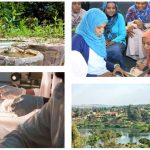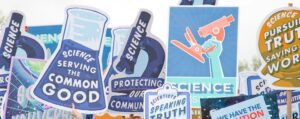
Migration policy for sustainable development: tips on evidence use
Last month, we were invited to facilitate a “masterclass” at the European Commission Joint Research Centre’s Evidence and Policy Summer School on migration and demography. Scientists and policymakers from 40 countries across the European neighbourhood gathered at the Institute of Applied Systems Analysis in Laxenburg, south of Vienna. A range of practical sessions focused on tools and approaches to strengthen the use of evidence in policy making in this area of critical importance for sustainable development in the European neighbourhood.
This was a great opportunity to explore approaches to strengthen research-policy networks in a different context from the countries with which we usually work.
In the keynote speeches of the first day, Vladimír Šucha, Director General of the Joint Research Centre, signalled a need for scientists and policymakers to understand and respect each other in order to move the quality of policy forward. He emphasized the need for a “Science to Policy 2.0”: going beyond traditional models in order to build a meaningful knowledge community in which scientists and policymakers tackle critical issues together. “We want to move the knowledge forward and for that knowledge to be in the service of society” he said, adding that, for that to happen, collaboration, co-creation and dialogue between scientists and policymakers is vital.
But, what does a knowledge community look like in real terms? What steps are needed to help us arrive at Science to Policy 2.0?
Our session aimed to strengthen the dialogue needed to address this question. We were keen to build on the combined experience of the scientists and policymakers in the room to enhance collective understanding of the research-policy interface in the field of migration and, from there, to co-develop practical recommendations for action in the workplace.
We focused on two broad issues: What factors are shaping evidence use in policy decisions around migration and demography? And, perhaps more importantly, how can we practically work together to foster more systematic uptake of research in this area?
We identified some of the main stages that are commonly cited as most critical for scientists and policymakers to interact: problem definition; research process; and communication of results.
Over the course of three days, we held four 90-minute workshops with a total of about 40 participants, representing a wide range of research and policy institutions in many different countries. Together, we built up a bank of practical ideas and suggestions – each group refining and building on the work of preceding groups. So, what themes and ideas emerged?
Problem definition and research questions
We often hear talk about the need to co-define research questions. But what should this look like in practice, exactly? Here are some of our participants’ top tips:
- Define through joint scoping – ideally via a face-to-face workshop to create joint ownership (2-4 hours could be sufficient). The groups felt this this would help to define clear needs (“what evidence do policymakers need that is not currently available?”) and make sure that both policymakers and scientists are asking the right questions.
- Include multiple different types of stakeholders at the outset and actively seek different perspectives. Participants suggested that, in addition to policymakers, NGOs and civil society organizations should be involved in refining research questions.
- Reflect honestly about your own motivations for engaging. One comment for researchers asked, “Are you getting in touch to give advice or to raise funds?”
- For researchers that are aiming to influence policy, a reminder to keep practical considerations in mind from the outset: “what policy challenge [are you] seeking to address?” and “What kind of budget is available to address these issues?”
Research process
During the research process, it is important to keep policymakers engaged because “good research takes time”, and because not all research will support the “preconceived policy line”. We asked our researchers and policymakers how to make this happen:
- Continue the conversation. Regular exchanges between policymaker and researchers during the research process is important. Researchers were advised to communicate and work openly during the process and be transparent about uncertainties.
- Researchers can give policymakers opportunities to feed in to key research tools, for instance questionnaires.
- Participants pointed to the value of researchers creating models and simulations – developing short-, medium- and long-term projections for results.
- For policymakers, being proactive and asking about the progress of the research was seen as a constructive way to drive engagement.
Communication and engagement
Our participants provided lots of recommendations highlighting the importance of clearly communicating research results to policy audiences, but also on the importance of communicating evidence to the general public to drive evidence-informed public debates and ensure both the issues, and the basis of policy decisions, are understood. Many felt this was a particular challenge with migration and demography issues in Europe. They advised:
Communicate evidence in an accessible and practical way to highlight what we already know (rather than what further research is required). Results have to be short and practical, but don’t give up on communicating limitations. Tips on how to do this effectively were:
- Simplify communication – write for a non-expert audience and minimize use of jargon and technical terms that can be misunderstood
- Use short direct messages – with daily life examples – do some tests with public to make sure they are working
- Use infographics and other visual tools
In order to support evidence-informed public debates:
- Increase communication with the general public in order to encourage open, public debate with relevant stakeholders
- Make policy proposals (and related data) understandable to the general public by using visualizations, and scenario-telling
When working with and using the media:
- Present the research together to the media (both researchers and policymakers)
- Help the media to understand science – organize training workshops with media representation so that they can better understand terminology, data and methodological issues
Encourage best practice: policymakers could do more to promote and celebrate the work of scientists that support policy making
Throughout the week, we heard many of the keynote speakers say that understanding the complexity of the system – and doing the job differently as a result – is critical. We were not expecting to find all the answers in our four short workshops, but it was great to have a chance to dig into these issues in more depth with such a vibrant community of researchers and policymakers. While the core issues are ones we recognize, it was useful to hear these expanded on in the context of migration and demography by such a diverse group, and we hope their practical tips can be useful for others working at the interface between science and policy.
The EC Masterclass was facilitated by INASP’s Verity Warne, Head of Marketing & Communications, and Emily Hayter, Acting Head of Evidence for Policy.

 Previous Post
Previous Post Next Post
Next Post


